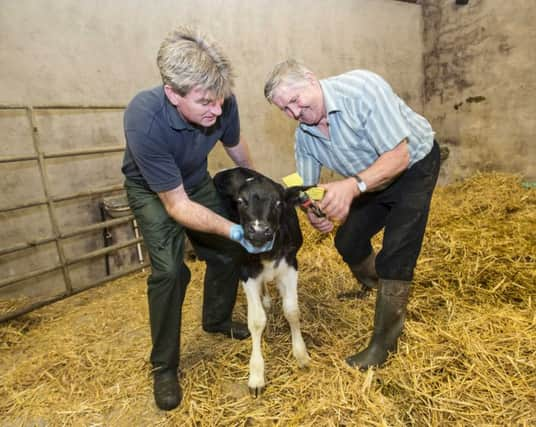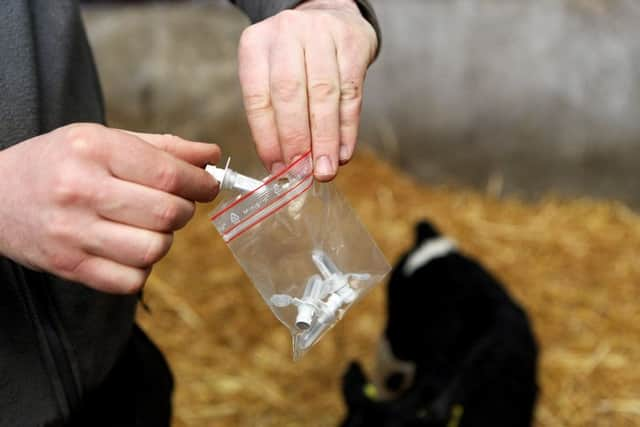Eradicating BVD


The introduction of the compulsory BVD Eradication Programme in spring 2016 was a vital step in tackling this highly infectious disease; however recent figures released by AHWNI suggested that around 50% of persistently infected (PI) calves born since March 2016 could still be alive on NI farms – highlighting that there is still a long way to go.
Now, with a compensation scheme aimed at incentivising the removal of PI animals set to come into force on 1st February, the outlook appears more positive. Under the scheme farmers can expect to receive £160 for a beef calf, £130 for a dairy heifer calf and £50 for a dairy male calf.
Advertisement
Hide AdAdvertisement
Hide AdA recent study revealed that almost 100% of non-vaccinated herds in Northern Ireland have had exposure to BVD. Many farmers are unaware of the virus circulating in their herds. Signs of infection vary from inapparent to severe and include fertility problems such as abortions and birth defects, scour and reduced milk yield. Other less directly associated illnesses, due to the effects of infection on the animals’ immune response, include an increased incidence of other diseases such as pneumonia, lameness or mastitis within the herd


The control of BVD revolves around the four pillars of PI identification and elimination, biosecurity, vaccination and monitoring. The most effective approach is one which removes PI animals whilst providing immunity to naïve dams to prevent further PI births. As farmers remove PI animals their herd will gradually become naïve to BVD infection. Vaccination of breeding stock with Bovilis® BVD prior to service provides immunity and peace of mind.
How does BVD spread?
This mainly occurs by nose-to-nose contact between infected cattle within the herd. Introduction of infected animals (either transiently or persistently) to the herd provides the greatest risk. Contact with infected animals from neighbouring farms, at marts or shows and during transport facilitates spread of disease. Animals can be infected by exposure to contaminated equipment, other species including sheep or by visitors to the farm.
What is a transiently infected (TI) animal?


Acute or transient infection occurs when an animal becomes infected for the first time at any point in its life after it is born. The animal may scour and occasionally it can result in death of the affected individual but often there can be no obvious signs of infection. When animals are transiently infected with BVD their immune system recognises the disease and responds by producing antibodies to protect against the effects of BVD. Transiently infected (TI) animals test virus positive at the time of infection but become virus negative within three weeks after infection. Once TI animals become clear of BVD virus they are no longer a threat to the rest of the herd. The majority of PI animals are born to cows which were transiently infected in the first four months of pregnancy.
What is a persistently infected (PI) animal?
Advertisement
Hide AdAdvertisement
Hide AdPI animals are born permanently infected with BVD virus. Persistent infection occurs when a pregnant dam is infected with BVD for the first time at some point during the first four months of pregnancy. Her developing calf does not recognise the virus as a threat and it does not mount an immune response to protect itself from the disease.
After infection, the in-utero calf may die (leading to abortion) or may be born normally, though persistently infected with the virus, and will shed high levels of the infectious virus thereafter. Persistently infected animals (PI) can appear normal but are a significant source of infection on farms. PIs are generally virus positive at all times when tested. If PI cows become pregnant they will give birth to PI calves.
The Role of Vaccination
Removal of PI animals will decrease the amount of virus circulating within the herd, and is an essential part of an eradication programme. However, if cows are not protected during pregnancy, transient infection during the first four months of pregnancy can result in the birth of future PI calves. The most effective approach to BVD control within the herd is to test and eradicate PI carriers, vaccinate with Bovilis BVD to protect pregnant cows, and be vigilant regarding biosecurity. On-going monitoring to ensure that the herd control measures are working is also important.
Seven critical points for BVD eradication
1. Take tissue tag samples from all calves within seven days of birth
Advertisement
Hide AdAdvertisement
Hide Ad2. Submit samples to a designated laboratory within a few days of sampling
3. Tissue tag and test all calves born including stillbirths
4. Carry out all necessary follow up testing once a PI is identified e.g. test dam of PI. If the dam is also positive all her other offspring must be tested
5. A PI animal should not be sold but should be isolated and culled at the earliest opportunity
6. Vaccinate all breeding animals before service each year to protect against infection
7. Maintain high level biosecurity and continue monitoring to ensure freedom from disease.